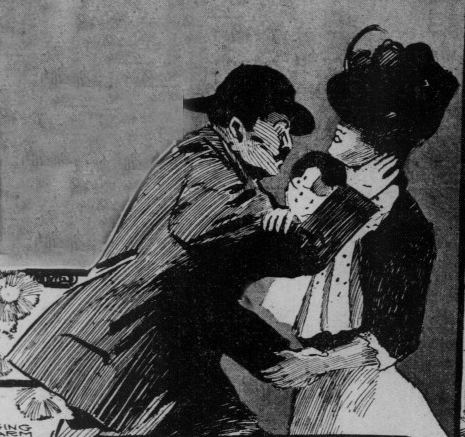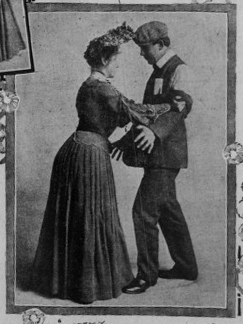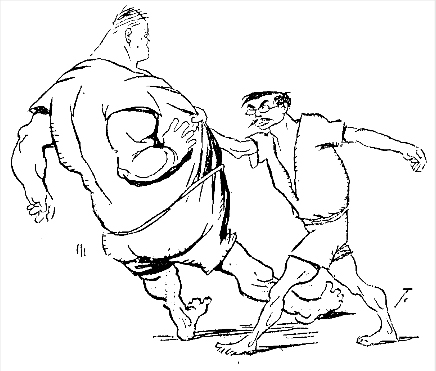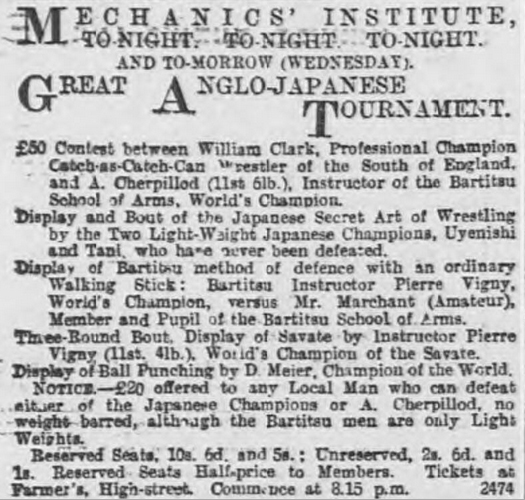- Originally published on the Bartitsu.org site on Sunday, 19th January 2014
From the San Francisco Call newspaper, August 1904.
The young lady demonstrating these self defence techniques is believed to be Mademoiselle Marie Gelas.
TIME and time again when some account appears in the papers describing a ruffianly attack upon a woman on the streets you have heard the women folks of your household exclaim: “I know I should faint if that happened to me.” Now, in nine cases out of ten they don’t faint, but put up a struggle, with overwhelming odds of strength against them, that is really to be admired.
The average woman in a desperate situation is more to be depended upon then the average man. Taking this fact for granted, the average woman, with the knowledge of a few defensive tricks, can easily handle the ruffian to be met with on the streets and prevent harm to herself.
At the present time San Francisco enjoys a reputation which it is safe to say no other city can boast of. It is that its women are safe to travel its streets at all hours unmolested, if they will go strictly about their business. It does happen sometimes that a women is accosted and, if she is in hearing distance of any one, no matter how bad the neighborhood, a cry for help will be answered.
This is in striking opposition to New York, the greatest city in the United States, where a woman cannot walk two blocks, after dark, without having some one speak to her. There may be occasions even here when a woman may meet a ruffian who is intent on robbery or under the influence of liquor. It is at such times that her presence of mind must outwit his strength. It is for that purpose that these few simple instructions are given.
First and foremost it must be remembered that to commit the instructions to memory is not all that is necessary. A woman must practice them and keep in practice, for this is the only keynote to a successful application. It will be found after practice that almost unconsciously when any one’s hands are placed on you, suddenly you will at once assume a defensive attitude, which if it is a serious case will give you an advantage, which will make you mistress of the situation. But without practice you will not be able to cope with your assailant.
Take the ruffian who attempts to steal your brooch or grasp you by the throat. Up go your hands and you take a grip of his forearm near the wrist and with a quick turn you bring his arm over your shoulder, making a fulcrum, and with a sudden jerk downward you will break his arm. In practice do this slowly, for it is most powerful and if you are not careful you will make your subject a candidate for the hospital.
In traveling alone on the streets at night it is a splendid idea to carry a parasol or umbrella. Keep it unlatched with the right hand on the slide at the ribs. If you are attacked and the ruffian tries to grasp you, it is very easy to open it in his face. You will find that the sudden opening of it will cause him to try and grab you, umbrella and all, but by shoving it into his face with the right hand extended you will be able to duck past him to one side and out of danger while he is trying to get the parasol or umbrella out of his way.

Another defense in the use of the hat pin when attacked from behind. The mere act of raising the arm will cause the ruffian to press downward instead of grasping you tighter around the throat. But he will not be able to stop you from getting your hat pin; then you can twist around and his face will be at your mercy.
Another good source of protection is to carry a good stout stick pin in your collar. This is easier to find and will allow of quicker action.
There is one way to place a ruffian, especially one who is under the influence of liquor, at your mercy, and that is the well-known trick of pulling the coat down off the shoulders. You then have his arms tied and he is powerless to do you any harm.
A trick which is likely to give one a shudder when it is considered, but yet one which is permissible when one feels that it is to be used in self-defense, is to grasp the face, gouging the thumb deep into the eye. There la no human being that can stand the pain and it will result in throwing the ruffian flat on his back. It will take all the fight out of a man. It is a game not to his liking.
There is another of the same order that will throw a ruffian. It is to grab the back of the neck with the left hand and shove the right in his face so that the fingers come under his nose. An upward pressure against the nose will throw him off his balance in a second and he will go down. There is no stopping; the strongest man in the world cannot stand the pain. It makes him as helpless as a child.
An act which requires a great deal of practice, but is very effective when accomplished, is to grab the wrist when one is being struck and jerk it in the direction of the blow. This, in many cases, will pull the arm out of the socket at the shoulder, but to accomplish it one must be exceedingly quick with arms and feet, for it means that you must sidestep out of range as you grab the wrist.
Another thing that is done under the same circumstance is to sidestep and grasp the wrist with both hands and quickly turn the arm outward. This will also throw him off his balance and more than likely will bring him to the ground. Always remember one thing: never step backward, for you lose your balance and put yourself at a disadvantage. Practice stepping sideways out of danger. By practice you will find which hand is going to be used and you can take the other side.
Another thing to remember is to watch the eyes of your assailant. He has got to look where he is going to grab and you will be able to forecast his move. Just as soon as you down your ruffian get away, using all your powers of speech to summon help.














